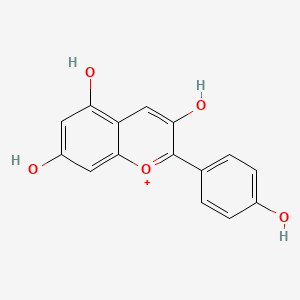| MeSH term | MeSH ID | Detail |
|---|---|---|
| Cystitis | D003556 | 23 associated lipids |
| Parkinsonian Disorders | D020734 | 20 associated lipids |
Pelargonidin
Pelargonidin is a lipid of Polyketides (PK) class. The involved functions are known as Uptake, Intestinal Absorption, glucose uptake, Process and Metabolic Inhibition. Pelargonidin often locates in Serosal, Mucous Membrane, brush border membrane, Membrane and Cell surface. The associated genes with Pelargonidin are SLC5A1 gene, SLC2A2 gene, Homologous Gene, F3 gene and CRSP3 gene. The related experimental models are Knock-out.
Cross Reference
Introduction
To understand associated biological information of Pelargonidin, we collected biological information of abnormalities, associated pathways, cellular/molecular locations, biological functions, related genes/proteins, lipids and common seen animal/experimental models with organized paragraphs from literatures.
What diseases are associated with Pelargonidin?
There are no associated biomedical information in the current reference collection.
Possible diseases from mapped MeSH terms on references
We collected disease MeSH terms mapped to the references associated with Pelargonidin
PubChem Associated disorders and diseases
What pathways are associated with Pelargonidin
There are no associated biomedical information in the current reference collection.
PubChem Biomolecular Interactions and Pathways
Link to PubChem Biomolecular Interactions and PathwaysWhat cellular locations are associated with Pelargonidin?
Visualization in cellular structure
Associated locations are in red color. Not associated locations are in black.
Related references are published most in these journals:
| Location | Cross reference | Weighted score | Related literatures |
|---|
What functions are associated with Pelargonidin?
Related references are published most in these journals:
| Function | Cross reference | Weighted score | Related literatures |
|---|
What lipids are associated with Pelargonidin?
There are no associated biomedical information in the current reference collection.
What genes are associated with Pelargonidin?
Related references are published most in these journals:
| Gene | Cross reference | Weighted score | Related literatures |
|---|
What common seen animal models are associated with Pelargonidin?
Knock-out
Knock-out are used in the study 'MATE2 mediates vacuolar sequestration of flavonoid glycosides and glycoside malonates in Medicago truncatula.' (Zhao J et al., 2011).
Related references are published most in these journals:
| Model | Cross reference | Weighted score | Related literatures |
|---|
NCBI Entrez Crosslinks
All references with Pelargonidin
Download all related citations| Authors | Title | Published | Journal | PubMed Link |
|---|---|---|---|---|
| Han Y et al. | Ectopic expression of apple F3'H genes contributes to anthocyanin accumulation in the Arabidopsis tt7 mutant grown under nitrogen stress. | 2010 | Plant Physiol. | pmid:20357139 |
| Sahay A and Shakya M | Structure prediction of dihydroflavonol 4- reductase and anthocyanidin synthase from spinach. | 2010 | Bioinformation | pmid:21364828 |
| Morant M et al. | Metabolomic, transcriptional, hormonal, and signaling cross-talk in superroot2. | 2010 | Mol Plant | pmid:20008451 |
| Halbwirth H | The creation and physiological relevance of divergent hydroxylation patterns in the flavonoid pathway. | 2010 | Int J Mol Sci | pmid:20386656 |
| Sentandreu E et al. | LC-DAD-ESI/MS(n) determination of direct condensation flavanol-anthocyanin adducts in pressure extracted pomegranate (Punica granatum L.) juice. | 2010 | J. Agric. Food Chem. | pmid:20839870 |
| Salvatierra A et al. | Comparison of transcriptional profiles of flavonoid genes and anthocyanin contents during fruit development of two botanical forms of Fragaria chiloensis ssp. chiloensis. | 2010 | Phytochemistry | pmid:20800857 |
| Medjakovic S et al. | Potential health-modulating effects of isoflavones and metabolites via activation of PPAR and AhR. | 2010 | Nutrients | pmid:22254019 |
| Tsao R | Chemistry and biochemistry of dietary polyphenols. | 2010 | Nutrients | pmid:22254006 |
| Azzini E et al. | Bioavailability of strawberry antioxidants in human subjects. | 2010 | Br. J. Nutr. | pmid:20487578 |
| Takasawa R et al. | Delphinidin, a dietary anthocyanidin in berry fruits, inhibits human glyoxalase I. | 2010 | Bioorg. Med. Chem. | pmid:20801663 |
| Zhao Q et al. | Anthocyanins profile of grape berries of Vitis amurensis, its hybrids and their wines. | 2010 | Int J Mol Sci | pmid:20559511 |
| Wang LS et al. | Antioxidant and pro-oxidant properties of acylated pelargonidin derivatives extracted from red radish (Raphanus sativus var. niger, Brassicaceae). | 2010 | Food Chem. Toxicol. | pmid:20600520 |
| Boase MR et al. | Isolation and antisense suppression of flavonoid 3', 5'-hydroxylase modifies flower pigments and colour in cyclamen. | 2010 | BMC Plant Biol. | pmid:20540805 |
| de Pascual-Teresa S et al. | Flavanols and anthocyanins in cardiovascular health: a review of current evidence. | 2010 | Int J Mol Sci | pmid:20480037 |
| Treutter D | Managing phenol contents in crop plants by phytochemical farming and breeding-visions and constraints. | 2010 | Int J Mol Sci | pmid:20479987 |
| Kovinich N et al. | Functional characterization of a UDP-glucose:flavonoid 3-O-glucosyltransferase from the seed coat of black soybean (Glycine max (L.) Merr.). | 2010 | Phytochemistry | pmid:20621794 |
| Roghani M et al. | Oral pelargonidin exerts dose-dependent neuroprotection in 6-hydroxydopamine rat model of hemi-parkinsonism. | 2010 | Brain Res. Bull. | pmid:20558255 |
| Cvorovic J et al. | Oxidative stress-based cytotoxicity of delphinidin and cyanidin in colon cancer cells. | 2010 | Arch. Biochem. Biophys. | pmid:20494645 |
| Stushnoff C et al. | Flavonoid profiling and transcriptome analysis reveals new gene-metabolite correlations in tubers of Solanum tuberosum L. | 2010 | J. Exp. Bot. | pmid:20110266 |
| Suttana W et al. | Differential chemosensitization of P-glycoprotein overexpressing K562/Adr cells by withaferin A and Siamois polyphenols. | 2010 | Mol. Cancer | pmid:20438634 |
